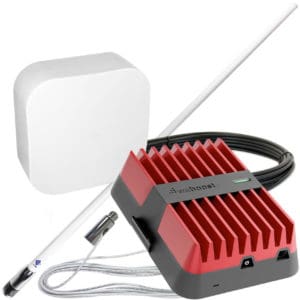
Getting out on the boat in coastal waters can separate us from important phone calls from family and the office that we’d rather not miss. That is, unless our boat is equipped with a high-gain marine cellular antenna.
The Marine weBoost Drive Reach Cell Signal Booster is a great example of the accessibility and power available for cell phones within 15 to 20 miles offshore.
“This kit includes a high-gain outside antenna for either the RFI 82-inch Whip or the Poynting high-gain omni antenna,” explained Marketing Director Chad Steglich of Powerful Signal of Hurricane, Utah.
The 29.5-inch Poynting OMNI-493 UV-stable ASA antenna produces 6 to 9 dBi of gain, while the much longer 81.9-inch RFI CDQ7199 Q-Fit fiberglass antenna puts out 4.5 to 8.5 dBi of gain.
The antenna inside the cabin offers a respectable level of gain up to 10 feet, which should cover all cell phone contacts within the nav station and helm, depending on the mounting location of the cell antenna. The weBoost system boosts 5G, 4G LTE and 3G cell signals for multiple users on all carriers including Verizon, AT&T, T-Mobile, UScellular and others.
On larger yachts with AC generators, the weBoost Drive Reach system can be powered using an optional 120 volt AC power supply in place of the standard 12 volt power supply included with each unit.
Winegard Marine offers their ConnecT WF-200M external antenna array system, which is a more rugged cell phone antenna arrangement for larger yachts and commercial vessels. Within coastal areas of North America, your crew can stay connected with friends and family with uninterrupted coverage while using voice communication or while surfing the Internet.
Winegard’s distinctive antenna array is designed to shrug off a harsh marine environment in extreme temperatures and sea conditions. The antenna array includes five antennas mounted on a base, which is affixed to a stable platform outside the cabin.
A 25-foot Ethernet cable connects the antenna array to a small, unobtrusive indoor unit, which communicates with cell phones throughout the vessel. The indoor unit may be mounted in the standing position, affixed to a bulkhead or lying down flat on the nav table or other available surface.
Just as boating lifestyles are highly varied, so too are Winegard’s affordable, pre-loaded data plans, which range from 1GB to 20GB. If you decide to install a Winegard cellular system, you can take advantage of the company’s prepaid plan, which is priced according to the data level you select.
Shakespeare, a name we routinely associate with VHF antennas, also manufactures radios and other electronic equipment, such as its STREAM Wireless Cell Booster. The STREAM cellular antenna system enables your tablet, cell phone, mobile hotspot or other cellular device in coastal and inland waters.
At dockside, use the STREAM to enhance weak Wi-Fi signal reception. If you are receiving only spotty reception out on the water, the STREAM will enhance the signal you are already receiving. Though signal reception and enhancement might not be on the same level as more expensive units, the system can be used to enhance signals within a few miles of the coast.
The STREAM signal booster works well with the leading telephone services, including AT&T and T-Mobile, plus Verizon 4G, 3G and 2G networks within U.S. and Canadian coastal and inland waterways.
The Shakespeare STREAM Wireless Booster set-up kit comes complete with the wireless booster unit, a 23-volt DC power cable, a helm antenna, an exterior marine antenna, and a 20-foot, low-loss cable.
Wherever you are within North American coastal or inland waters, there is an affordable cell antenna system ready to keep you connected with land life. Consider the options, install the selection best fitting your vessel’s size and layout and stay in touch with family and friends as you enjoy your voyage.
ON contributing editor and circumnavigator-author Bill Morris believes the best strategy for succeeding as an offshore voyager is to keep systems simple and, if possible, manual. Key to survival are a windvane self-steering system, a basic array of electronics and an aggressive alternative energy battery charging matrix. Bill is the author of The Windvane Self-Steering Handbook (International Marine, 2004) and The Captain’s Guide to Alternative Energy Afloat (Seaworthy Publications, 2019).
